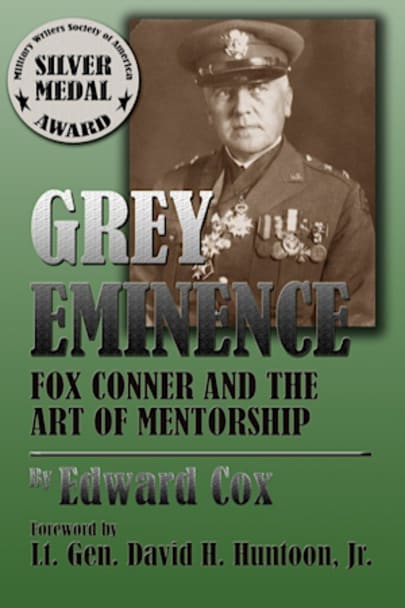To those who have heard of him, Fox Conner’s name is synonymous with mentorship. He is the “grey eminence” within the Army whose influence helped to shape the careers of George Patton, George Marshall, and, most notably, President Eisenhower. What little is known about Conner comes primarily through stories about his relationship with Eisenhower, but little is known about Fox Conner himself. … After a career that spanned four decades, this master strategist ordered all of his papers and journals burned. Because of this, most of what is known about Conner is oblique, as a passing reference in the memoirs of other great men. This book combines existing scholarship with long-forgotten references and unpublished original sources to achieve a more comprehensive picture of this dedicated public servant. The portrait that emerges provides a four-step model for developing strategic leaders that still holds true today. First and foremost, Conner was a master of his craft. Secondly, he recognized and recruited talented subordinates. Then he encouraged and challenged these protégés to develop their strengths and overcome their weaknesses. Finally he wasn’t afraid to break the rules of the organization to do it. Here, for the first time ever, is the story of Major General Fox Conner.
more



Major General Fox Connor is not generally a well-known name outside of the circle of military professionals. The names of General’s Eisenhower, Marshall, and Patton still carry historical significance in America. The author’s work is an account on the interwoven professional, and personal, relationships of several American Army generals identified as having Connor as a guiding figure in their careers. President Dwight Eisenhower described Conner as “the ablest man I ever knew.” (p.xv)
The author’s thesis is that Conner was a “master of his craft who recognized and recruited talented subordinates.” (p. xvii) that provided subordinates keys to success though his mentorship. He asserts that Conner’s tutelage as “a friend and father figure” (p. xix) who was willing to “provide advice, lend assistance, or call in a favor.” (p. xx) is still a model for leadership development.
Connor’s credibility during the Interwar period is established by the author, “Connor would be called upon by the Army as their artillery expert’ (p.41) During World War I, the author provides evidence that Connor was an exceptional staff officer, and commander, for General Pershing’s American Expeditionary Forces (AEF). He emphasizes how Connor recognized the potential talents of subordinates and encourages their growth even after the war ended. When introduced to Eisenhower, Connor took interest and began a mentor relationship. After the war, ‘General Connor was not satisfied with Eisenhower’s disdain for military history,” (p.89). Connor began furthering Eisenhower’s military history education. While Connor was assigned to in Panama with Eisenhower, “He began a deliberate campaign to turn his executive officer into a military aficionado like himself.” (p. 89). The author details examples of Connor’s willingness to call in favors and provide detailed career advice to Eisenhower, Marshall, and Patton even after his own retirement from the Army.
Unfortunately, Conner had “ordered all of his papers and journals burned.” (p. xvi). The author did exceptional work on researching sources. Cox’s notes are an expansive list of public records, military archives, official reports, period relevant military journals and articles, newspapers and published biographies. (pp. 109-119) The author draws heavily from USMA records in the first two chapters to detail both Connor’s known achievements and general facts of cadet life at the USMA during that time. Cox was able to use these records to provide colorful details of Connor’s early years such as, “He earned 384 demerits in the course of four years.” (p.16). While not specifically critical to the author’s thesis on Connor’s mentoring process, the details added perspective into the subject’s life.
The book is seven chapters of a well-researched chronological narrative. The first three chapters dedicated to Connor’s early life and experiences. The next three chapters detail the interactions of Connor with Marshall, Eisenhower and Patton. The final chapter is a short synopsis of Connor’s career and retirement. The organization the book contained awkwardly repetitive jumps in the chronology. His writing style contained a mixture of personal narrative intertwined with source document excerpts. When citing United States Military Academy (USMA), and numerous official public records, the author’s narrative abruptly changed to reviewing ledger entry citations. This was awkward writing style, for myself as the reader.
The author used twenty-two photographs, one map, and an illustration dispersed thought his book. The visuals did not generally correspond with the chronological sequencing within the book beyond the subject of the photo’s inclusion in that chapter. The photo of George Patton, captioned “and his 320-pound Jew Fish.” (p. 98) was a unique inclusion decision from the author during a topic of tanks.
Cox provided a researched look at the four-decade career of Major General Fox Connor. He clearly summarized the existence of the mentoring relationships of Connor. The book did not provide expansive details on that process beyond supervision and tutelage as “a friend and father figure” (p. xix) who was willing to “provide advice, lend assistance, or call in a favor.” (p. xx). It is not an unlikely inference to make that Connor had a lifelong mentoring process with his famous protégés. The research on Connor highlights his influence on subordinates with a focus on continued education and networking skills. However, Cox does not define a functional model for subordinate mentorship.